2014 NISSAN LEAF steering
[x] Cancel search: steeringPage 14 of 397

1. TRIP switch for twin trip odometer (P 2-6)
2. Trip computer switch (P 2-28)3. Instrument brightness control switch
(P 2-42)4. Headlight, fog light (if so equipped) and
turn signal switch
— Headlight (P 2-43)
— Turn signal light (P 2-45)
— Fog light (if so equipped) (P 2-45)
5. Steering-wheel-mounted controls (left side)
(See LEAF Navigation System Owner’s
Manual.)
—
Driving range button (if so
equipped)
— Audio control
— Bluetooth® Hands-Free Phone System
control
6. Steering wheel
— Power steering system (P 5-19)
— Horn (P 2-47)
— Driver’s supplemental air bag (P 1-35)
7. Wiper and washer switch (P 2-39)
8. Steering-wheel-mounted controls (right
side)
— Cruise control switches (P 5-15)
— ECO button (if so equipped) (P 2-47)
9. Fuse box cover (P 8-16)
10. Heated steering wheel (if so
equipped)(P 2-46)
11. Vehicle Dynamic Control (VDC) OFF
switch (P 2-49)
12. Charge timer OFF switch(P 2-50)
COCKPIT
0-6Illustrated table of contents
Page 15 of 397
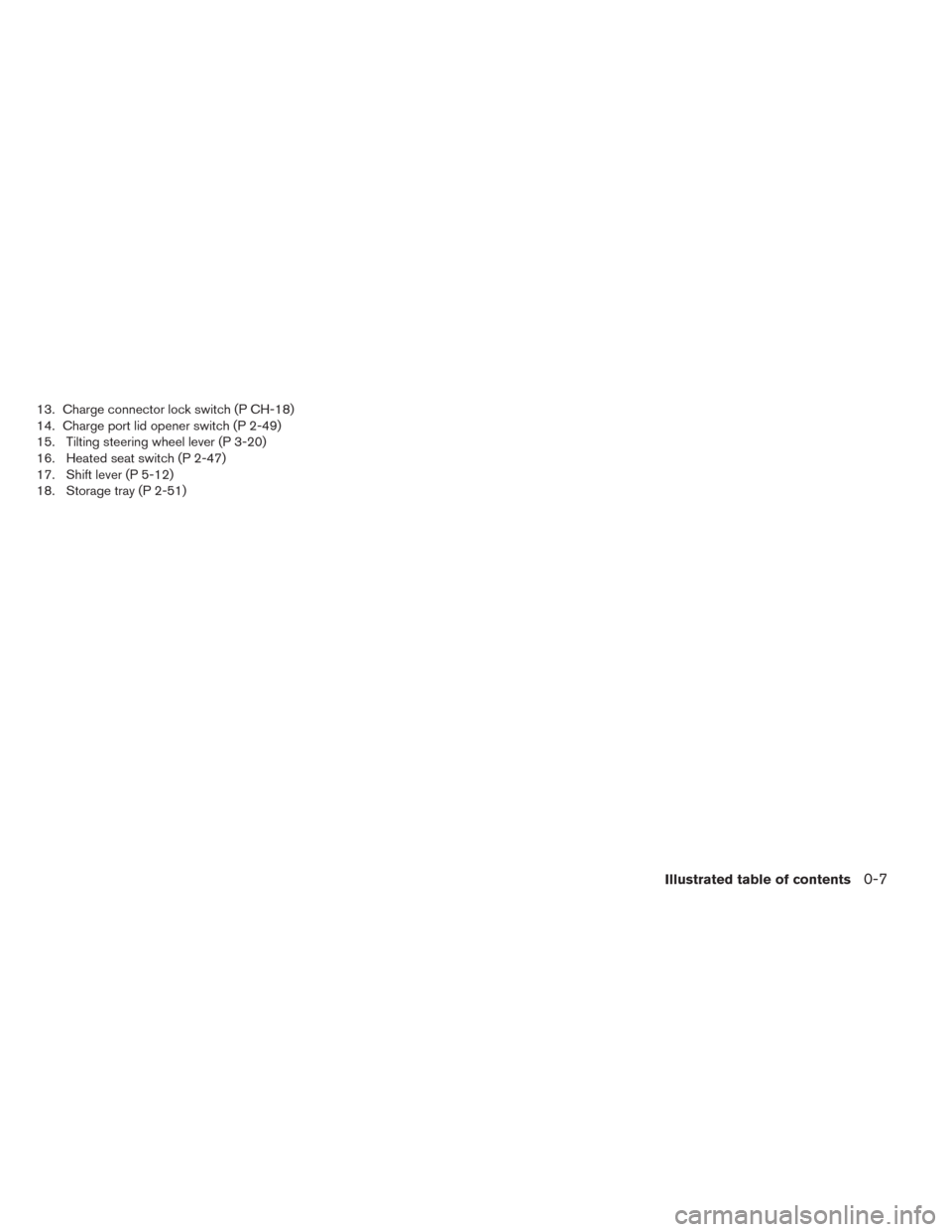
13. Charge connector lock switch (P CH-18)
14. Charge port lid opener switch (P 2-49)
15. Tilting steering wheel lever (P 3-20)
16. Heated seat switch (P 2-47)
17. Shift lever (P 5-12)
18. Storage tray (P 2-51)
Illustrated table of contents0-7
Page 19 of 397

Warning
lightName Page
12-volt battery charge
warning light2-14
Anti-lock Braking System
(ABS) warning light2-15
Approaching Vehicle
Sound for Pedestrians
(VSP) system warning
light2-15
BRAKE system warning
light (yellow)2-15
BRAKE warning light (red) 2-16
Electric shift control sys-
tem warning light2-17
Warning
lightName Page
EV system warning light 2-17
Headlight warning light 2-17
Low battery charge warn-
ing light2-17
Low tire pressure warning
light2-17
Master warning light (red/
yellow)2-19
Power steering warning
light2-19
Seat belt warning light 2-19
Warning
lightName Page
Supplemental air bag
warning light2-19
Vehicle Dynamic Control
(VDC) warning light2-20
WARNING AND INDICATOR LIGHTS
Illustrated table of contents0-11
Page 50 of 397
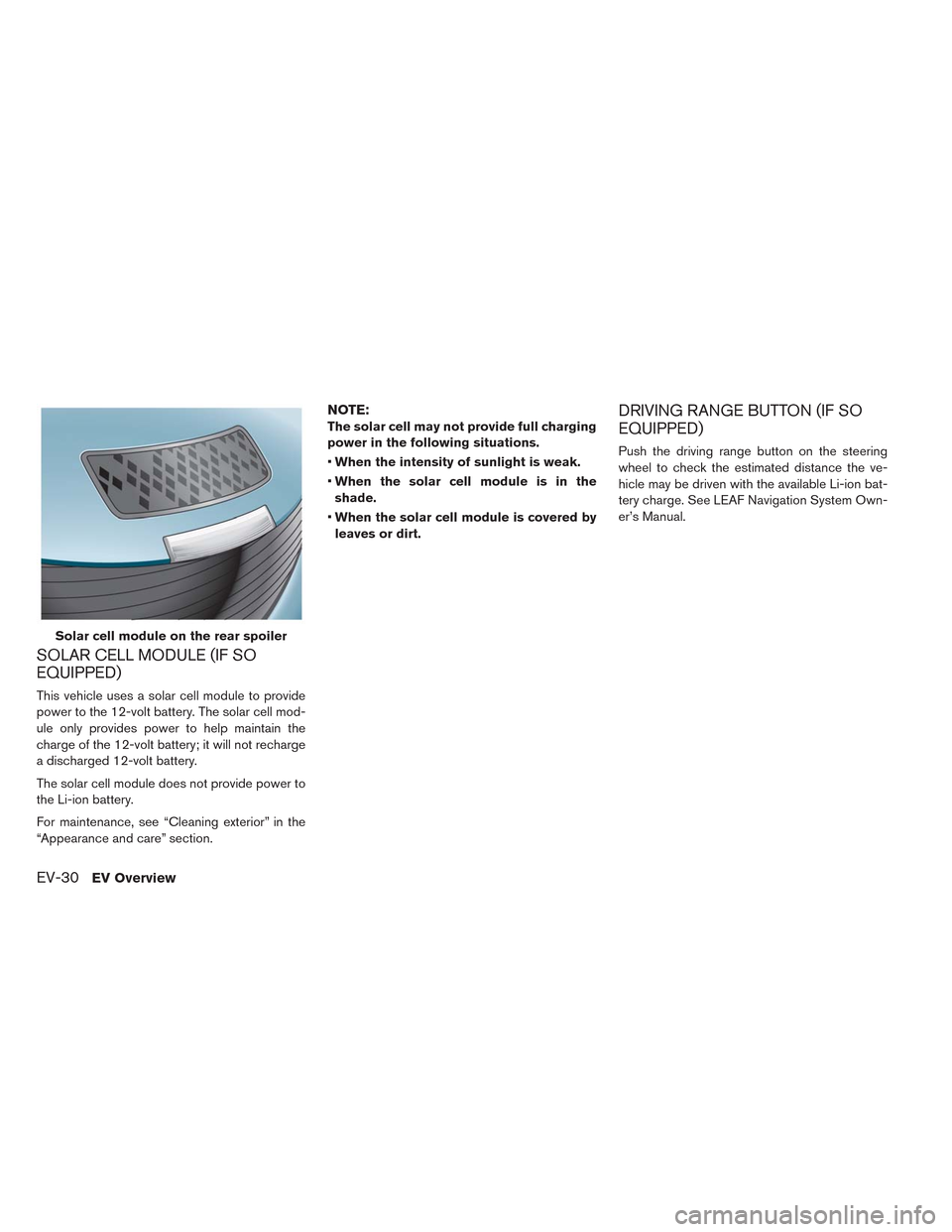
SOLAR CELL MODULE (IF SO
EQUIPPED)
This vehicle uses a solar cell module to provide
power to the 12-volt battery. The solar cell mod-
ule only provides power to help maintain the
charge of the 12-volt battery; it will not recharge
a discharged 12-volt battery.
The solar cell module does not provide power to
the Li-ion battery.
For maintenance, see “Cleaning exterior” in the
“Appearance and care” section.
NOTE:
The solar cell may not provide full charging
power in the following situations.
•When the intensity of sunlight is weak.
•When the solar cell module is in the
shade.
•When the solar cell module is covered by
leaves or dirt.DRIVING RANGE BUTTON (IF SO
EQUIPPED)
Push the driving range button on the steering
wheel to check the estimated distance the ve-
hicle may be driven with the available Li-ion bat-
tery charge. See LEAF Navigation System Own-
er’s Manual.
Solar cell module on the rear spoiler
EV-30EV Overview
Page 121 of 397

7. If the booster seat is installed in the front
passenger seat, push the power switch to the
ON position. The front passenger air bag sta-
tus light
may or may not illuminate
depending on the size of the child and the
type of booster seat used. See “Front passen-
ger air bag and status light”.
PRECAUTIONS ON SUPPLEMENTAL
RESTRAINT SYSTEM
This Supplemental Restraint System (SRS) sec-
tion contains important information concerning
the following systems.
• Driver and passenger supplemental front-
impact air bag (NISSAN Advanced Air Bag
System)
• Front seat-mounted side-impact supplemental
air bag
• Roof-mounted curtain side-impact supplemen-
tal air bag
• Seat belt with pretensioner
Supplemental front-impact air bag system:
The NISSAN Advanced Air Bag System can help
cushion the impact force to the head and chest of
the driver and front passenger in certain frontal
collisions.
Front seat-mounted side-impact supple-
mental air bag system:This system can help
cushion the impact force to the chest and pelvic
area of the driver and front passenger in certain
side impact collisions. The side air bag is de-
signed to inflate on the side where the vehicle is
impacted.Roof-mounted curtain side-impact supple-
mental air bag system:This system can help
cushion the impact force to the head of occu-
pants in front and rear outboard seating positions
in certain side impact collisions. In a side impact,
the curtain air bags are designed to inflate on the
side where the vehicle is impacted.
These supplemental restraint systems are de-
signed tosupplementthe crash protection pro-
vided by the driver and passenger seat belts and
arenot a substitutefor them. Seat belts should
always be correctly worn, and the occupant
should be seated a suitable distance away from
the steering wheel, instrument panel and door
finishers. See “Seat belts” for instructions and
precautions on seat belt usage.
The supplemental air bags operate only
when the power switch is in the ON posi-
tion.
After the power switch is placed in the ON
position, the supplemental air bag warning
light illuminates. The supplemental air bag
warning light will turn off after about 7
seconds if the systems are operational.
SUPPLEMENTAL RESTRAINT
SYSTEM
Safety–Seats, seat belts and supplemental restraint system1-35
Page 122 of 397
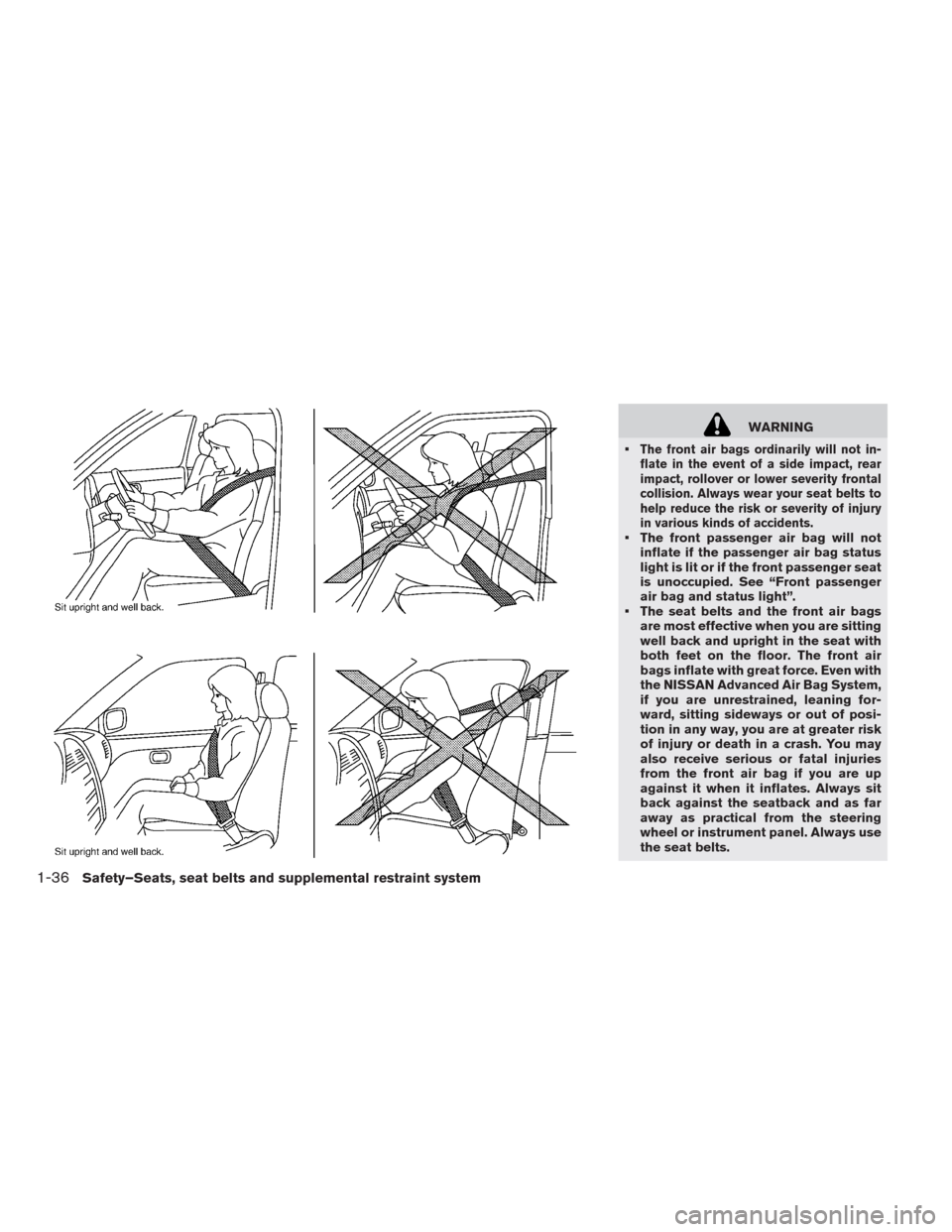
WARNING
•
The front air bags ordinarily will not in-
flate in the event of a side impact, rear
impact, rollover or lower severity frontal
collision. Always wear your seat belts to
help reduce the risk or severity of injury
in various kinds of accidents.
• The front passenger air bag will not
inflate if the passenger air bag status
light is lit or if the front passenger seat
is unoccupied. See “Front passenger
air bag and status light”.
• The seat belts and the front air bags
are most effective when you are sitting
well back and upright in the seat with
both feet on the floor. The front air
bags inflate with great force. Even with
the NISSAN Advanced Air Bag System,
if you are unrestrained, leaning for-
ward, sitting sideways or out of posi-
tion in any way, you are at greater risk
of injury or death in a crash. You may
also receive serious or fatal injuries
from the front air bag if you are up
against it when it inflates. Always sit
back against the seatback and as far
away as practical from the steering
wheel or instrument panel. Always use
the seat belts.
1-36Safety–Seats, seat belts and supplemental restraint system
Page 123 of 397
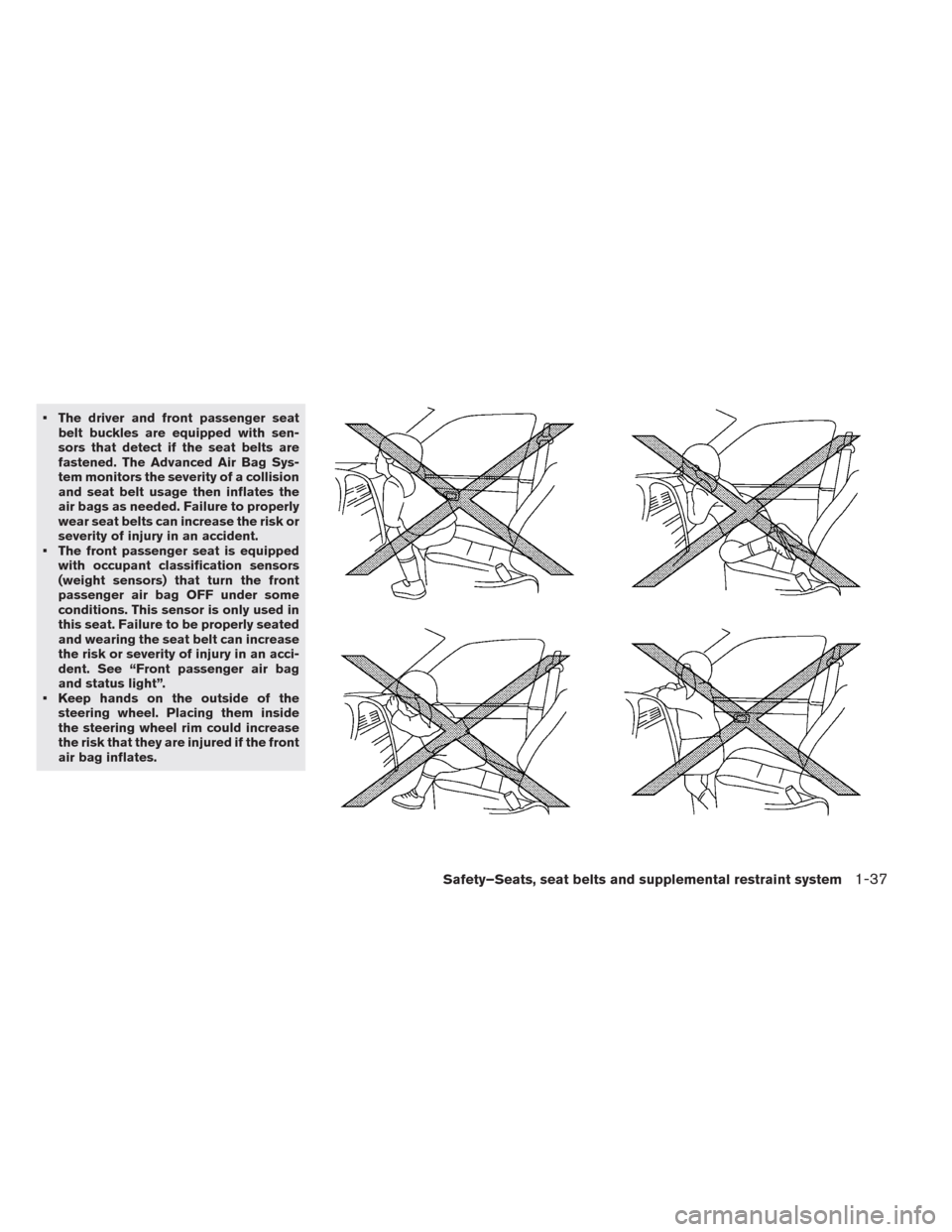
• The driver and front passenger seat
belt buckles are equipped with sen-
sors that detect if the seat belts are
fastened. The Advanced Air Bag Sys-
tem monitors the severity of a collision
and seat belt usage then inflates the
air bags as needed. Failure to properly
wear seat belts can increase the risk or
severity of injury in an accident.
• The front passenger seat is equipped
with occupant classification sensors
(weight sensors) that turn the front
passenger air bag OFF under some
conditions. This sensor is only used in
this seat. Failure to be properly seated
and wearing the seat belt can increase
the risk or severity of injury in an acci-
dent. See “Front passenger air bag
and status light”.
• Keep hands on the outside of the
steering wheel. Placing them inside
the steering wheel rim could increase
the risk that they are injured if the front
air bag inflates.
Safety–Seats, seat belts and supplemental restraint system1-37
Page 127 of 397
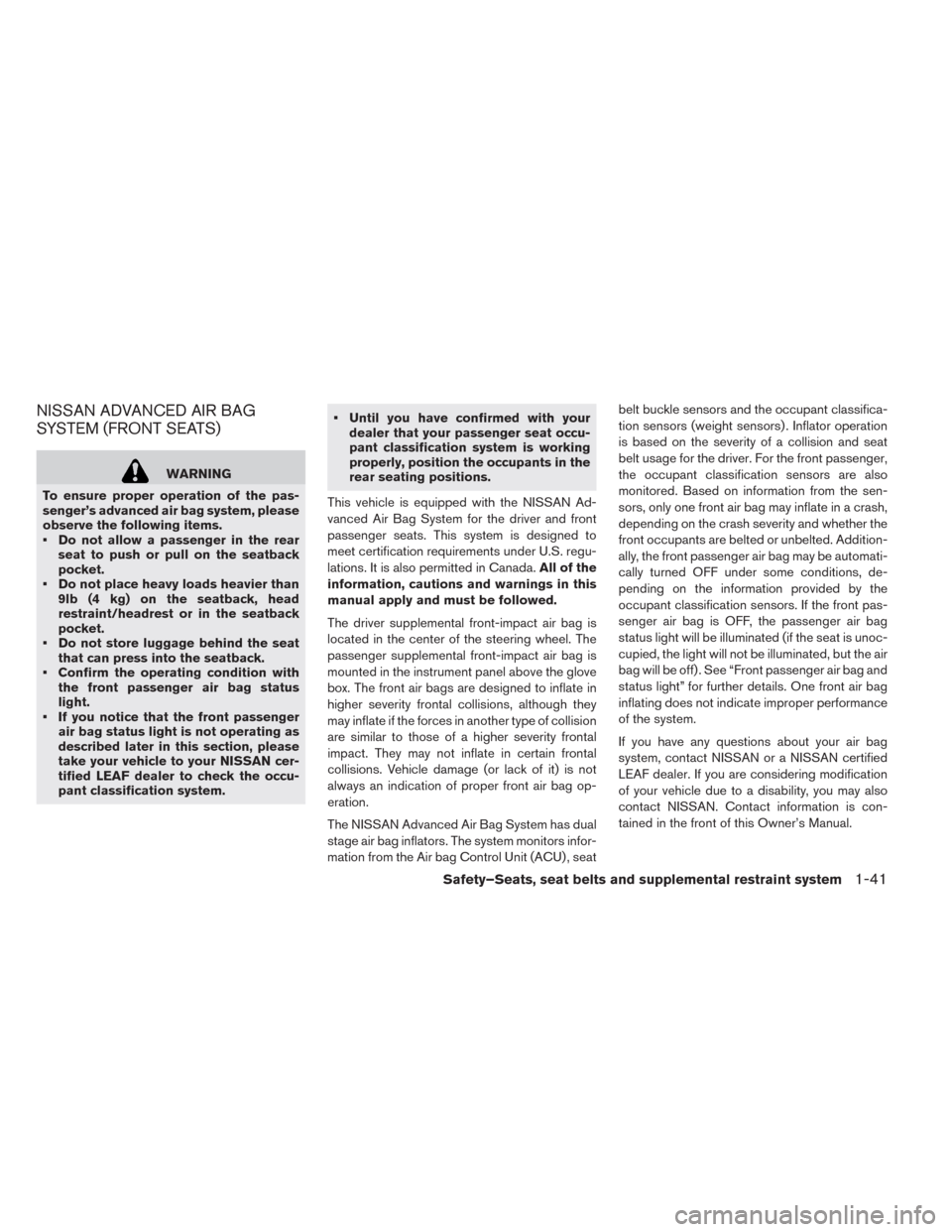
NISSAN ADVANCED AIR BAG
SYSTEM (FRONT SEATS)
WARNING
To ensure proper operation of the pas-
senger’s advanced air bag system, please
observe the following items.
• Do not allow a passenger in the rear
seat to push or pull on the seatback
pocket.
• Do not place heavy loads heavier than
9lb (4 kg) on the seatback, head
restraint/headrest or in the seatback
pocket.
• Do not store luggage behind the seat
that can press into the seatback.
• Confirm the operating condition with
the front passenger air bag status
light.
• If you notice that the front passenger
air bag status light is not operating as
described later in this section, please
take your vehicle to your NISSAN cer-
tified LEAF dealer to check the occu-
pant classification system.• Until you have confirmed with your
dealer that your passenger seat occu-
pant classification system is working
properly, position the occupants in the
rear seating positions.
This vehicle is equipped with the NISSAN Ad-
vanced Air Bag System for the driver and front
passenger seats. This system is designed to
meet certification requirements under U.S. regu-
lations. It is also permitted in Canada.All of the
information, cautions and warnings in this
manual apply and must be followed.
The driver supplemental front-impact air bag is
located in the center of the steering wheel. The
passenger supplemental front-impact air bag is
mounted in the instrument panel above the glove
box. The front air bags are designed to inflate in
higher severity frontal collisions, although they
may inflate if the forces in another type of collision
are similar to those of a higher severity frontal
impact. They may not inflate in certain frontal
collisions. Vehicle damage (or lack of it) is not
always an indication of proper front air bag op-
eration.
The NISSAN Advanced Air Bag System has dual
stage air bag inflators. The system monitors infor-
mation from the Air bag Control Unit (ACU) , seatbelt buckle sensors and the occupant classifica-
tion sensors (weight sensors) . Inflator operation
is based on the severity of a collision and seat
belt usage for the driver. For the front passenger,
the occupant classification sensors are also
monitored. Based on information from the sen-
sors, only one front air bag may inflate in a crash,
depending on the crash severity and whether the
front occupants are belted or unbelted. Addition-
ally, the front passenger air bag may be automati-
cally turned OFF under some conditions, de-
pending on the information provided by the
occupant classification sensors. If the front pas-
senger air bag is OFF, the passenger air bag
status light will be illuminated (if the seat is unoc-
cupied, the light will not be illuminated, but the air
bag will be off) . See “Front passenger air bag and
status light” for further details. One front air bag
inflating does not indicate improper performance
of the system.
If you have any questions about your air bag
system, contact NISSAN or a NISSAN certified
LEAF dealer. If you are considering modification
of your vehicle due to a disability, you may also
contact NISSAN. Contact information is con-
tained in the front of this Owner’s Manual.
Safety–Seats, seat belts and supplemental restraint system1-41